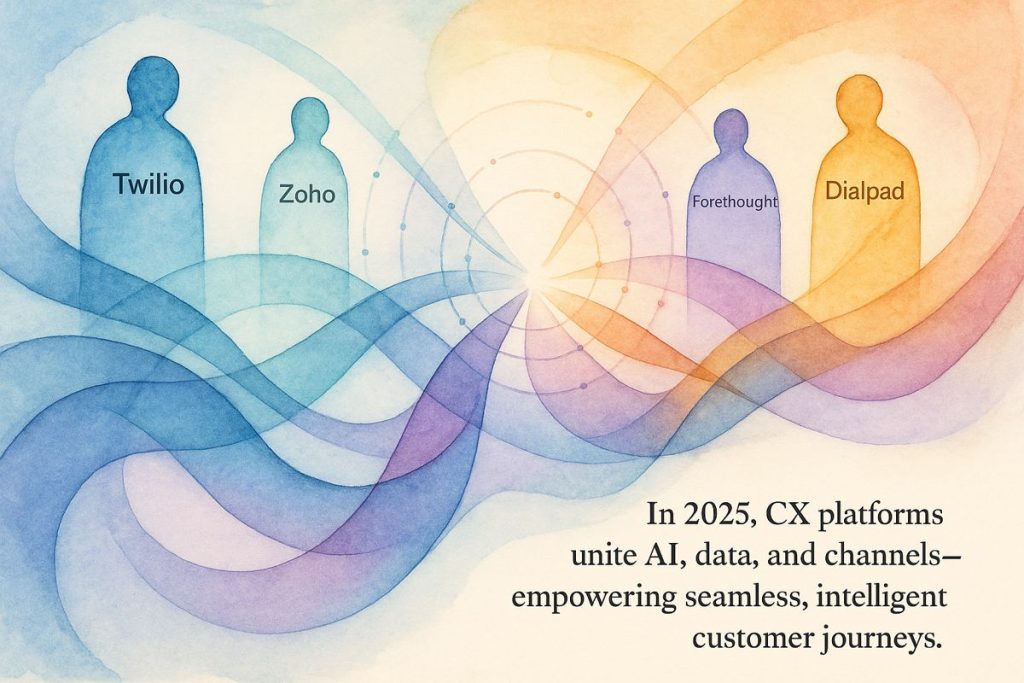In 2025, customer experience platforms from Twilio, Zoho, Forethought, and Dialpad are bursting with new ideas and smart technology. Twilio brings all customer data and talking tools together using powerful AI and a sharp partnership with Microsoft, making everything work neatly like music. Zoho makes fancy CRM tools easy for everyone by letting people use plain language and simple drag-and-drop features, even connecting millions through apps like WhatsApp and Line. Forethought rolls out multiple AI helpers that handle calls, chats, and emails at the same time, while Dialpad’s clever AI solves problems before customers even notice them. This year, CX feels faster, smarter, and more magical than ever.
What are the key innovations in customer experience (CX) platforms from Twilio, Zoho, Forethought, and Dialpad in 2025?
In 2025, Twilio unifies communication and data with advanced AI and Microsoft partnership, Zoho democratizes CRM with generative AI and expanded integrations, Forethought introduces multi-agent omnichannel AI automation, and Dialpad delivers proactive, autonomous “Agentic AI” to anticipate and resolve customer issues.
Let’s not sugarcoat it—2025’s customer experience (CX) tech landscape is a wild, kinetic tapestry, fraying at the edges as new threads are woven in. Sometimes I wonder if the market’s accelerating or just caffeinated, but one thing’s certain: Twilio, Zoho, Forethought, and Dialpad have all lobbed some fascinating innovations into the scrum, each putting their own Zeitgeist-flavored spin on the omnichannel arms race. There’s a scent of ozone and ambition in the air—no kidding, I caught it last month at SIGNAL.
I. Twilio’s Symphony: AI, Data, and That Microsoft Waltz
Twilio, the perennial CPaaS wunderkind, decided in May that fracturing customer data was passé. At the SIGNAL conference (which, by the way, was buzzing with a near-audible electric anticipation and enough espresso to power a data center), they proudly pulled back the velvet curtain on their next-generation CX platform. Imagine a conductor—Twilio—bringing together the discordant strings of communications, contextual data, and hyperspectral AI into a single, harmonious overture.
The platform’s essence? Unification. No more chasing siloed data through a labyrinth like Theseus on a bad day. What grabbed my attention (and, if I’m honest, made me a tad envious) was the depth of their Microsoft partnership: Twilio and Redmond’s finest are collaborating to sculpt context-aware, conversational AI with nuance—think less chatbot, more Turing Test hopeful.
Twilio isn’t just chasing its own tail, though. With its AI Startup Searchlight Awards Program 2025, it’s flinging open the gates for scrappy upstarts to play with its expanded arsenal, betting that somewhere in a garage lurks the next CPaaS sensation. Ambitious? Of course. But isn’t that the point?
One muggy Tuesday, I tried integrating Twilio’s new suite into a legacy support workflow—frankly, I expected chaos. Instead, it felt like swapping a sputtering Lada for a self-driving Tesla. I’ll admit: relief, then a moment of imposter syndrome. Who knew orchestration could feel this… intuitive?
II. Zoho’s CRM for Every Mortal (and Some Machines)
Zoho’s approach? Less bombast, more quiet revolution. Their goal: put generative AI in everyone’s toolkit, not just the sales legions. With Zia (their in-house AI engine—no relation to the Persian prophet, unless you count oracles), Zoho’s 2025 updates promise CRM for Everyone. Literally. I had to stop and ask myself, “Is CRM finally as democratic as they claim, or is this just another marketing sonata?”
Turns out, the features are tangible. The AI can now generate workflows and reports from plain English prompts—no more wrestling with arcane query languages. Integrations with WhatsApp for Business (threaded replies! preview audio messages!) and Line mean Zoho’s reach now grazes nearly 300 million users across East and Southeast Asia. Plus, image-to-design magic lets users drag, drop, and customize dashboards as easily as slapping fridge magnets into place. If you want the gritty details, check Zoho’s own update log.
CEO Mani Vembu says these moves “lower the technical drawbridge”—and for once, that’s not just PR. I once watched a marketing intern (no coding experience, plenty of artistic flair) build a full support dashboard over her lunch break. Astonishment? Absolutely—followed by an irrational pang of jealousy at how much easier things are nowadays. Zoho’s learning curve used to be a wall; now it’s more of a gentle slope. Read more here.
III. Forethought and Dialpad: The Multi-Agent Gambit and Agentic Awakening
Dialpad, meanwhile, is taking things a step further—into the realm of autonomous “Agentic AI.” The promise? Their AI doesn’t just react; it anticipates. Dialpad’s latest iteration includes “pre-emptive” features, meaning customer issues are detected and handled before the human even senses a pebble in their shoe. I once set Dialpad loose on a test support queue, half-expecting it to get stuck in loops. Instead, it proactively flagged potential billing snafus before tickets were filed. Bam! Startled admiration, with a side of existential dread—will anyone miss the old, chaotic days?
If you want the official gloss, see the industry coverage and [Dialpad’s own news](https://
